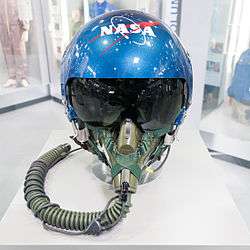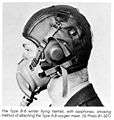Flight helmet
A flight helmet, sometimes referred to as a "bone dome" or "foam dome", is a special type of helmet primarily worn by military aircrew.


A flight helmet can provide:[1]
- Impact protection to reduce the risk of head injury (e.g. in the event of a parachute landing) and protection from wind blast (e.g. in the event of ejection).
- A visor to shield the eyes from sunlight, flash and laser beams.
- Noise attenuation, headphones and a microphone (except when included in a mask).
- A helmet mounted display, mounting for night vision goggles and/or a helmet tracking system (so the aircraft knows where the pilot is looking).
The design of a flight helmet may also consider:[1]
- Comfort - including the weight, centre of gravity and provision for cooling and ventilation.
- Compatibility with an oxygen mask (for high-altitude flight and NBC protection).
History of flight helmets
In the first days of aviation the leather helmets used in motor-racing were adopted by pilots as head protection.[2] The initial design of early leather flying helmets was adapted during the 1930s to become the type B helmet which enabled the external attachment of radio earphones oxygen masks and removable goggles to protect pilots eyes from the elements.[3][4]
By World War II, an oxygen mask was added to the equipment as planes flew higher where thinner air required a breathable air supply to the pilots and crew. After World War II into the Korean War, the leather headpiece was gradually replaced with a hard helmet needed as head protection during bailing out (and later with high velocity ejection).[5] Also, goggles were replaced by a visor that was incorporated to the helmet and tinted to protect against sun. Current head gear (appears after the Vietnam War) also includes communications equipment (head set and microphones) to let pilots communicate with ground operations and their crew.[6]
References
- Aerospace International (magazine), March 2011, pages 26-29
- Rood, Graham. "A Brief History of Flying Clothing" (PDF). Journal of Aeronautical History. Archived from the original (PDF) on 19 March 2015. Retrieved 7 March 2015.
- Rood, Graham. "A Brief History of Flying Clothing" (PDF). Journal of Aeronautical History. Archived from the original (PDF) on 19 March 2015. Retrieved 7 March 2015.
- http://www.456fis.org/HISTORY_OF_FLIGHT_HELMETS.htm
- "US Military Aviation". www.salimbeti.com. Retrieved 25 August 2015.
- "Types of Pilot Oxygen Masks". www.buzzle.com. Archived from the original on 23 September 2015. Retrieved 25 August 2015.
- Grothe, Solveig (March 26, 2016). "Mit dem Kopf durch die Wand (With the head through the wall)". Der Spiegel online. Archived from the original on May 23, 2018. Further background (1912 Flight magazine image caption) in hoaxeye.com. Helmet is often incorrectly referred to as a football helmet.
External links
| Wikimedia Commons has media related to Pilot helmets. |




